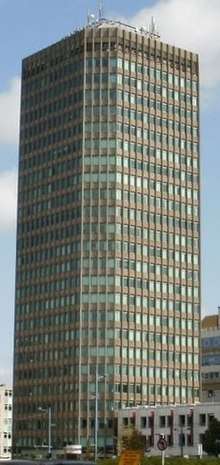Architecture of Cardiff
Architecture in Cardiff, the capital city of Wales, dates from Norman times to the present day. Its urban fabric is largely Victorian and later, reflecting Cardiff's rise to prosperity as a major coal port in the 19th century. No single building style is associated with Cardiff, but the city centre retains several 19th and early 20th century shopping arcades.
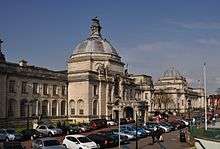
The city is noted for its fantasy castles, Cardiff Castle and Castell Coch, both by the Victorian architect William Burges. The well-preserved early 20th century Civic Centre, surrounding Cathays Park, was described as one of the best examples of civic planning in Britain.[1]
The city contains a number of notable modern buildings and engineering projects. These include the Millennium Stadium (1999) in the city centre and several examples in the major urban regeneration project of Cardiff Bay, for example the Wales Millennium Centre and the Senedd (National Assembly Building).
The western suburb of St Fagans contains an open-air museum of Welsh vernacular architecture, the St Fagans National History Museum.
Building materials
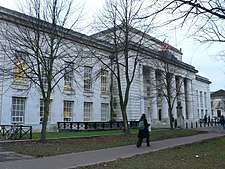
The common building materials of Cardiff's Victorian and Edwardian buildings are Bath stone, blue Pennant stone and red brick – except in Cathays Park, where Portland stone predominates. Grey Lias stone features heavily in the construction of the city's medieval buildings (the keep of Cardiff Castle, Llandaff Cathedral and St John the Baptist's church), but is absent from later buildings. Two recent buildings in Cardiff Bay, the Senedd and the Wales Millennium Centre, make conspicuous use of Welsh slate together with glass and steel.
Early and medieval buildings
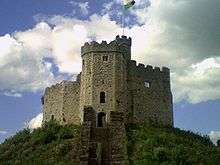
Perhaps the most noted individual building in the city is Cardiff Castle, a fortress of Roman foundation with a ruined 12th-century medieval keep and exterior walls.[2] After Cardiff Castle, the oldest remaining building in the city centre is St John's Parish Church, which dates from the 12th century but was almost totally reconstructed during the 15th century. It has a fine Perpendicular style nave and tower.[3]
The medieval town walls were removed as the town developed and nowadays only two very small sections remain.[2] The modernised Womanby Street is one of the few remaining original medieval streets, that lead from the town's original quay to the castle.
Two monastic buildings existed in Cardiff, Greyfriars (demolished for Capital Tower) and Blackfriars, established in the late 13th century. Greyfriars was converted into a family mansion but was demolished to make way for a carpark and office block during the 20th-century. The foundations of Blackfriars can still be seen in Bute Park.[2]
Llandaff Cathedral dates from 1107 but was built on the site of a pre-Norman building. It was significantly extended in the 13th and 15th centuries.[4] Nearby are the ruins of the Bishop's Palace, destroyed by the forces of Owain Glyndŵr in 1400.
19th-century architecture
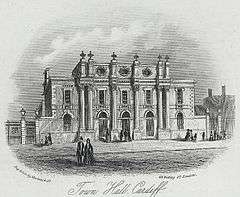
With the arrival of the railways and a rapidly expanding coal export industry, Cardiff changed beyond recognition during the mid nineteenth century. It became the largest town in Wales in 1875.[5] From the 1840s new residential streets were built in Butetown and Temperance Town (completed 1864).[6]
Much of the land on which Cardiff was built was owned by John Crichton-Stuart, 2nd Marquess of Bute. Much of Cardiff and many of its buildings were designed by the marquess's architect, Alexander Roos.[7]
New churches and chapels were created, including a new Romanesque St Mary's Church on Bute Street. Noted local architect John Prichard designed St Margaret's Church, Roath and St John's Church, Canton, also refurbishing Llandaff Cathedral. The (surviving) Tabernacl chapel in The Hayes is described as the "finest classical chapel of the period".[6] Important architects from outside Wales arrived, designing St David's Roman Catholic church (1887) in Charles Street, amongst others.[8]
In 1853 a new "graceless but vigorous" colonnaded Town Hall and Corn Exchange (Cardiff's fourth town hall) replaced the old Guildhall in High Street.[6] Horace Jones of London had been the winners of the design competition, controversially, because the cost limit was £8,000, while Jones scheme was estimated at £11,690. The building was extended in 1876 but was eventually replaced in the early 20th century.[9]
New shops, bank buildings and hotels appeared, including the Royal Hotel (1866), Great Western Hotel (1876) and Park Hotel (1885).[5] Cardiff's "fascinating and delightful" Victorian shopping arcades were built: High Street Arcade (1885), Wyndham Arcade (1886), Castle Arcade (1887) and Morgan Arcade (1896).[8]
Important new public buildings were created, including the Central Library, Cardiff Royal Infirmary, St David's Hospital, the Theatre Royal (later renamed the Prince of Wales Theatre), Grand Theatre (Westgate Street) and the University College of South Wales.[8]
Impressive new buildings were constructed in Butetown to serve the dockland economy. These included the Coal Exchange (1883–86) in Mount Stuart Square and the imposing French-Gothic Pierhead Building (1896) at the docks entrance.[8]
Cardiff Castle was restored and redesigned between 1868 and 1890.[8] The private apartments of the third Marquis of Bute in Cardiff Castle, commissioned from the architect William Burges, are an acknowledged masterpiece of the Victorian Gothic Revival. Burges's other buildings in Cardiff are Castell Coch, a 13th-century castle rebuilt (with some artistic licence) as a residence for Bute, and Park House which influenced domestic architecture in Cardiff and was a prototype for Burges's own house in London, The Tower House.
20th-century architecture
The civic centre at Cathays Park, whose earliest building dates from 1901, is a notable example in the United Kingdom of city planning on Beaux-Arts principles.
In the 1941 Cardiff Blitz, Llandaff Cathedral sustained a direct hit. It was restored by George Pace, who added a concrete parabolic arch in the nave to support a new sculpture by Jacob Epstein, Majestas.
The Festival-style Empire Pool was built in the Cardiff Arms Park for the 1958 Empire Games;[10] this was demolished in 1999.
BBC Broadcasting House in Llandaff, designed in 1967 by Dale Owen of Percy Thomas & Partners, who had worked in Chicago under Walter Gropius, drew inspiration from modernist architecture in the United States such as Gropius's Harvard Graduate Center and Ludwig Mies van der Rohe's apartments on Lake Shore Drive, Chicago.[11]
Cardiff Central police station, built between 1966 and 1968 in the classical civic centre of Cardiff is described as "The most successful post-war building in Cathays Park."[12]
Cardiff Bay Visitor Centre (Will Alsop and John Lyall, 1990) – claimed to have "single-handedly put Cardiff on the architectural map".[13] In 2010 it was dismantled to make way for a new road.[14]
21st-century architecture
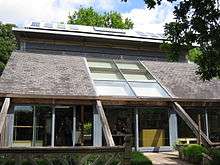
Cardiff began the new century in 2000 with the completion of a House of the Future at the St Fagans National History Museum. It was a joint initiative between BBC Wales and Malcolm Parry of the Welsh School of Architecture and aimed to create a zero carbon house on a reasonable £120,000 budget, using the latest technologies.[15]
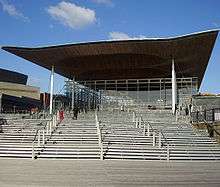
Cardiff Bay underwent an urban regeneration scheme in the late 20th century and its Barrage was a major civil engineering project. New buildings of note in this area include:
- The Senedd, the debating chamber of the National Assembly for Wales (Richard Rogers, 2006), shortlisted for the RIBA Stirling Prize.
- The Wales Millennium Centre (opened 2004), awarded the Wales Eisteddfod Gold Medal in 2005.[16] – this project was preceded by the Cardiff Bay Opera House scheme which, if built, would have been the first building by Zaha Hadid in the United Kingdom. The building was refused a Lottery grant as one had already been granted to the Millennium Stadium (HOK Sport, 1999).
- 260m 'post modern' facade to the BBC TV Production Centre (2011), by Fashion Architecture Taste.[17]
Cardiff city centre is approximately 1 mile north of Cardiff Bay. Notable modern buildings in the city centre include:

- The new Cardiff Central Library (opened in March 2009) is an example of sustainable architecture. The building was specifically designed to be energy-efficient, and includes a sedum grass roof to improve insulation and reduce rainwater run-off, coloured glass panels and solar shading to prevent excessive heat gains, and a full Building Management System to provide climate control to individual floors. As a result of these measures the building was awarded a BREEAM rating of 'excellent'.[18]
- Royal Welsh College of Music & Drama, North Road, completed a £22.5 million redevelopment in 2011. The impressive exterior blends with the nearby Civic Centre and parklands using Portland stone cladding and vertical cedar louvres. The interior contains an art gallery and a new recital hall.[19]
The Cardiff International Sports Village and St David's 2 shopping centre are large leisure complexes underway as of 2009.
Criticism
A number of important buildings have been lost to development in the latter decades of the 20th century. The Institute of Welsh Affairs (IWA) has bemoaned the "frightful" new multi-storey car parks that have replaced key Victorian buildings.[20] For example, the classical old fire station in Westgate Street was replaced by a car park in the 1960s. The white stuccoed Capel Ebenezer was replaced by a superstore and the grand Wood Street Congregational Church was replaced by an office block.[20] The IWA argued for more thought by planners for creative re-use of "our sadly neglected historic town centre buildings".[20]
References
- Tinniswood, A. A History of British Architecture BBC History, updated 29 March 2011. Retrieved 24 October 2011.
- Museum of Wales 'Rhagor' webpages, Medieval Cardiff Archived 18 June 2011 at the Wayback Machine, 4 May 2007. Retrieved 24 October 2011.
- The City Parish of St John the Baptist, Cardiff Parish History (retrieved 25 October 2011)
- Llandaff Cathedral website A SHORT HISTORY Archived 17 December 2007 at the Wayback Machine updated 23 December 2010. Retrieved 25 October 2011.
- Stewart Williams (Ed.), "South Glamorgan – A County History", Stewart Williams Publishing (1975), pp. 84–85. ISBN 0-900807-19-9
- Stewart Williams (Ed.), "South Glamorgan – A County History", Stewart Williams Publishing (1975), pp. 79–82. ISBN 0-900807-19-9
- Stevens Curl, James; Wilson, Susan (2015). The Oxford Dictionary of Architecture. Oxford University Press. ISBN 9780199674985. Retrieved 29 July 2015.
- Stewart Williams (Ed.), "South Glamorgan – A County History", Stewart Williams Publishing (1975), pp. 86–89. ISBN 0-900807-19-9
- "Plans & Prospects: Architecture in Wales 1780–1914", Welsh Arts Council (1975), p. 49. ISBN 978-0-9500455-7-3
- "Cardiff Empire Games 1958". BBC News. 19 July 2012.
- Cherry, Monica (September 2005). "The Modern in Wales". The Twentieth Century Society. Retrieved 8 January 2015.
- John Newman (1995), The Buildings of Wales - Glamorgan, Penguin Books, p. 119, ISBN 0-14-071056-6
- Fiona Sturges (3 October 1998) "The 50 Best; THE BEST BUILDINGS; OF THE NINETIES", The Independent. Retrieved 13 February 2016.
- Hopkirk, E. Cardiff Bay visitor centre to be dismantled Building Design, 16 September 2010
- Adrian Mourby (2 March 2001). "How green is my chalet". Times Higher Education. Retrieved 20 March 2016.
- thefreelibrary.com The awards pile up for Wales' delightful 'armadillo'. Western Mail, 30 July 2005 (retrieved 24 October 2011)
- Murray, C. (Ed.) FAT completes 260m facade as part of new £30m BBC production village, The Architects Journal, 21 September 2011, p.10
- "How the 'One Team' approach will help shape tomorrow". Infoworks. Laing O'Rourke. Q1 2008 (23): 22. Retrieved 14 March 2009.
- Walesonline.co.uk Inside the new Royal Welsh College of Music and Drama 10 June 2011. Retrieved 25 October 2011.
- Blake, A. Cardiff's great Victorian architecture is 'under threat' South Wales Echo, 30 October 2010. Retrieved 24 October 2011.
External links

